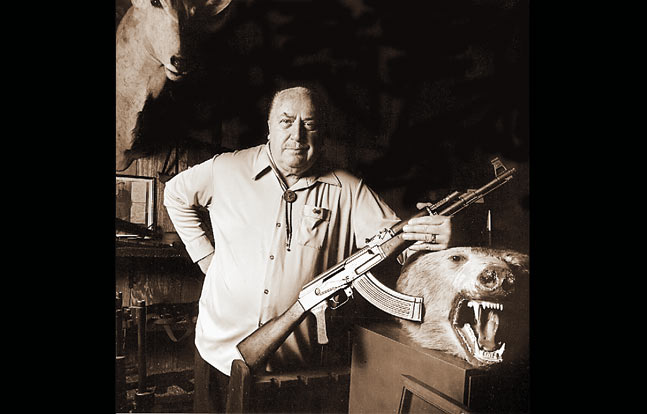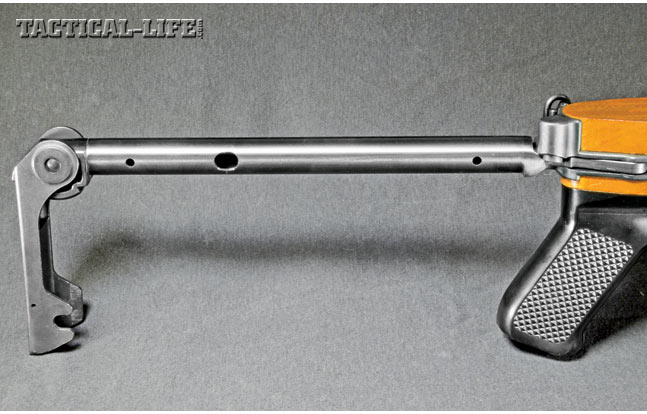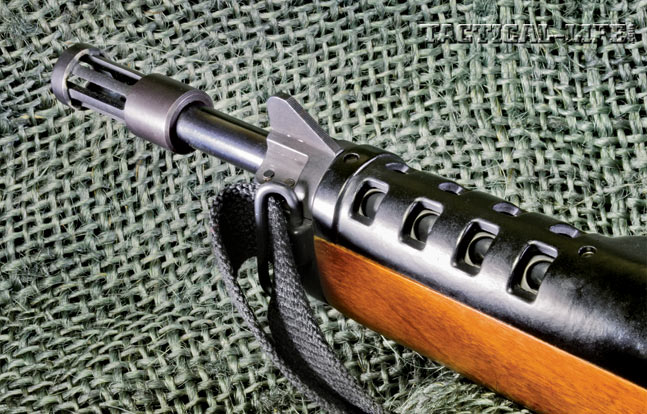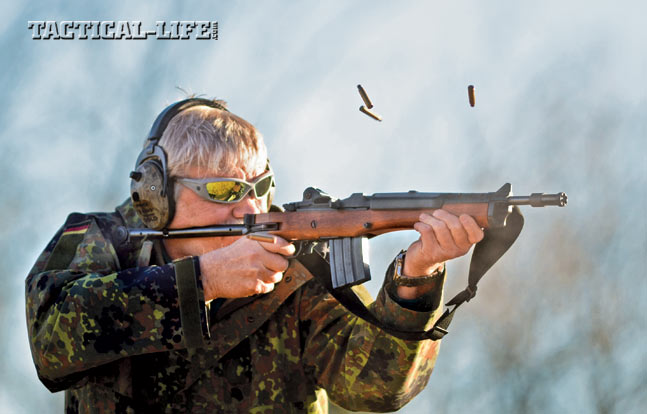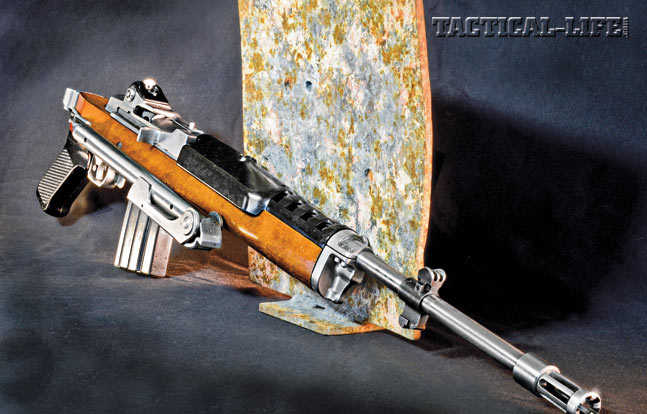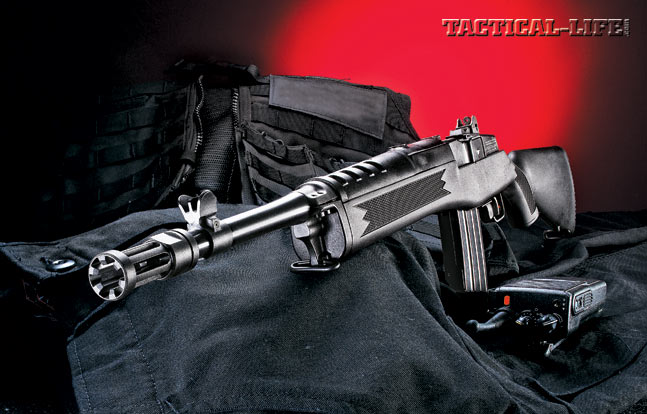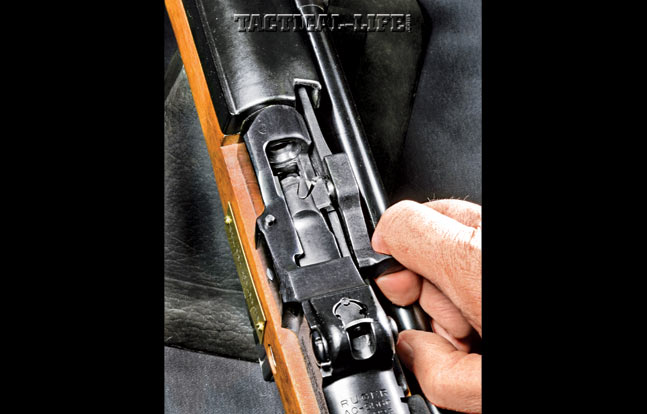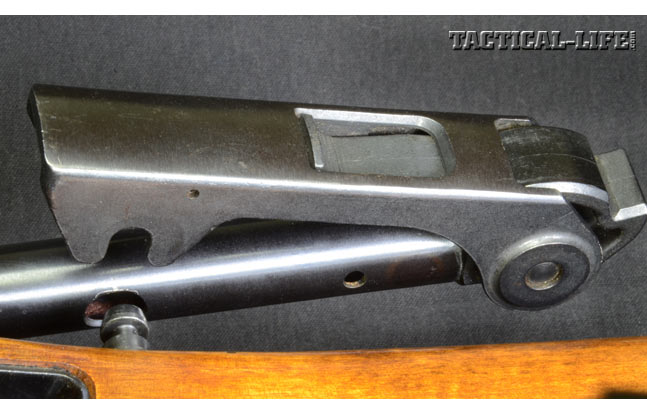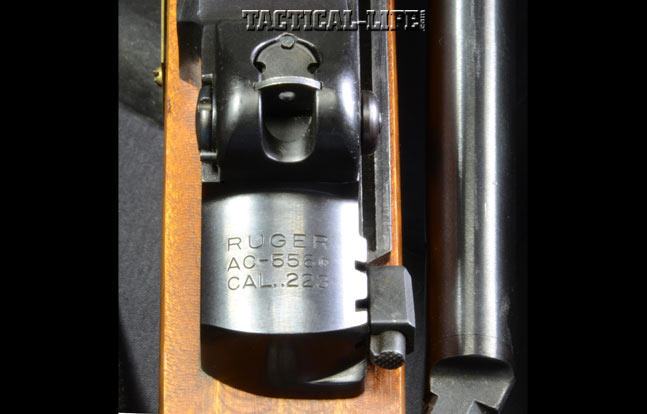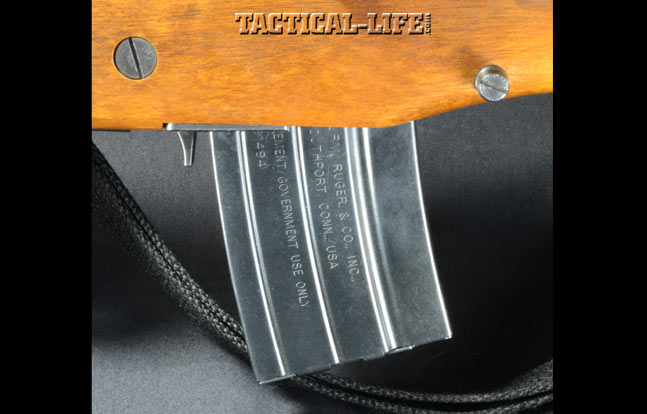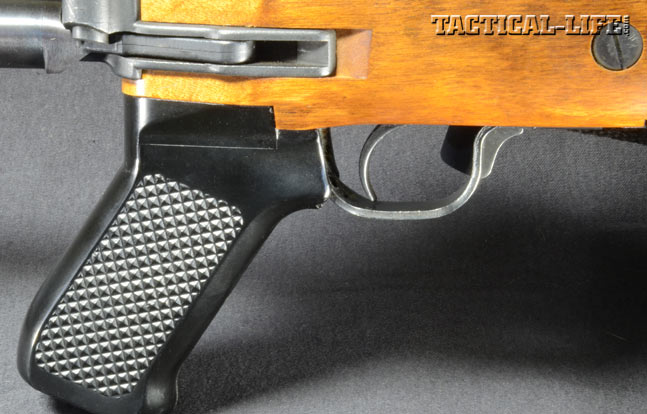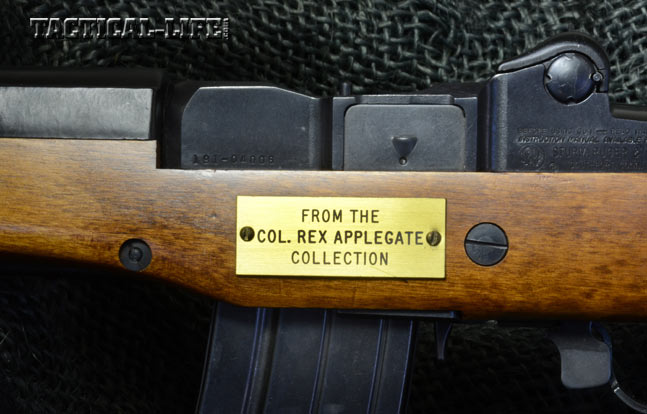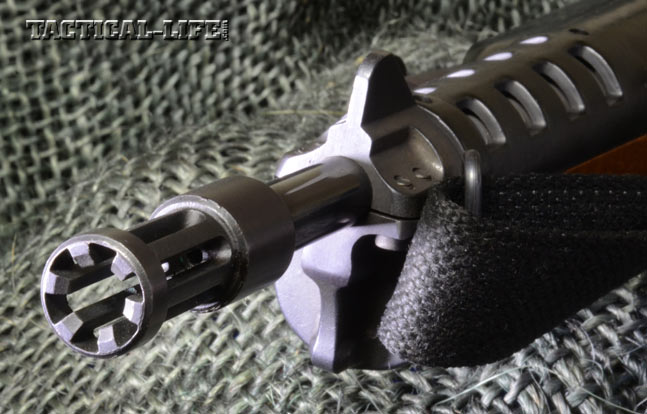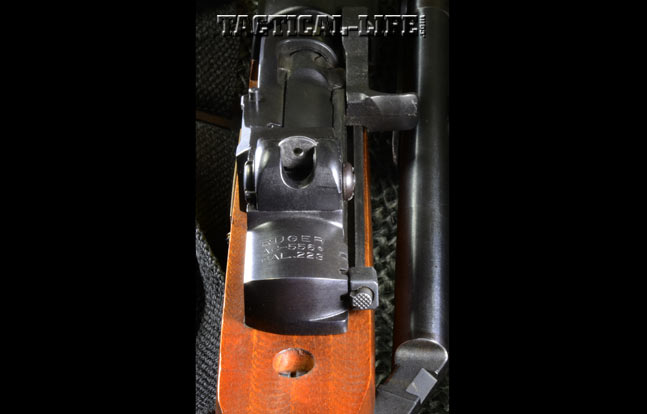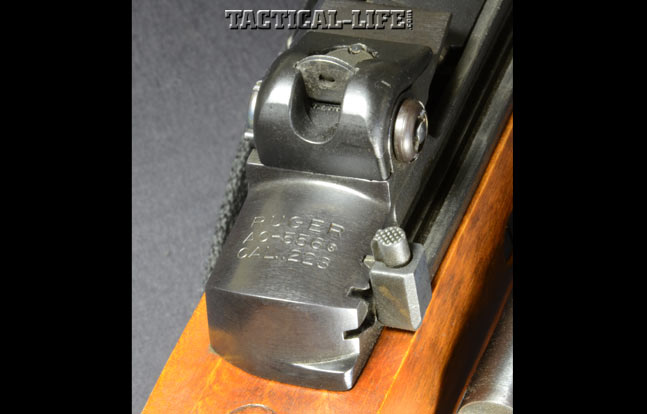Ruger has traditionally concentrated on the civilian market and, to some extent, the military and law enforcement market. The company’s primary military and law enforcement sales have been of handguns, though Ruger has made short forays into the tactical long gun market. In the mid-1990s, for example, Ruger introduced the MP9 submachine gun, which was only in production for a couple of years. Based on my tests of this SMG, it was a sound design, but since it was strictly a military and LE item, the limited market was already committed to the HK MP5. Ruger did offer an earlier select-fire weapon, though, that was more successful in the law enforcement market—the AC-556.
“The Mini-14 proved less expensive than the M16 and was less “aggressive” in appearance, an important consideration with many law enforcement agencies…”
First, however, I need to say a bit about the AC-556’s progenitor, the Ruger Mini-14 carbine (Click here to read a review of the Mini-14). From the beginning, the Mini-14 was intended to look like a scaled-down version of the M14 rifle, which was still the standard U.S. military rifle—though it was being replaced by the M16—in the late 1960s when Ruger began work on the Mini-14. Of course, the Mini-14 was a semi-auto chambered for the .223 round. Ruger found, however, that it couldn’t just scale down the M14; a substantial number of engineering changes were necessary to create a reliable rifle. By the time the Mini-14 was introduced in 1975, the bugs had been worked out, and it proved a very popular rifle with civilians and law enforcement agencies. In law enforcement usage, the Mini-14 proved less expensive than the M16 and was less “aggressive” in appearance, an important consideration with many law enforcement agencies.
The Mini-14 also achieved some overseas sales. It is probably best known for its use by the French police, but there were also sales to some Latin American countries, as well as Australia, Hong Kong, Great Britain and Bermuda. Many of the foreign sales were to correctional services, as were many U.S. government sales. Other U.S. users included the NYPD Emergency Service Unit as well as U.S. Marine Embassy Guards in some locations. Note that U.S. Marine Embassy Guards also carried Ruger revolvers at one time. The Ruger Mini-14 GB, a semi-auto “assault rifle” version, was widely purchased by law enforcement agencies.
Advertisement — Continue Reading Below

Applegate’s AC-556
Ruger introduced the select-fire AC-556 version of the Mini-14 specifically for military and law enforcement sales. Two basic versions of the AC-556 were offered: the AC-556 with a fixed stock and the AC-556GF with a side-folding stock. Also available were the AC-556K or KAC-556K (in stainless steel) with 13-inch barrels as opposed to the standard 18.5-inch barrel. The largest sales of the AC-556 were to the French police (2,500), the U.S. Department of State for embassy use (500) and the Bermuda Regiment for military use (500). Various other police departments purchased the AC-556 as well.
“I especially enjoyed shooting the carbine that formerly belonged to Col. Applegate…”
A friend of mine who is a collector of Class III weapons purchased the AC-556 that formerly belonged to Colonel Rex Applegate and which had been presented to him by Ruger, and I have had a chance to shoot it on a couple of occasions, including recently for this article. I also have encountered the platform at least once on a foreign close-protection team. I have always been quite impressed with the AC-556. One point I have especially noted is that it has always been utterly reliable when I have used it, and that includes with a variety of ammunition.
Advertisement — Continue Reading Below
I especially enjoyed shooting the carbine that formerly belonged to Col. Applegate. As I remember one evening he called me just as I had gone to sleep to discuss the AC-556, among other things. Col. Applegate was located in Oregon, which was two hours earlier than Missouri, where I lived, so he would occasionally call to talk at 9:00 or 9:30 his time, which was 11:00 or 11:30 my time. I never minded because the conversations were always enjoyable, and 15 years since his death, I still miss them. The night we discussed it, we were speculating about how much W.E. Fairbairn or John B. George, both fans of the M1 Carbine, would have appreciated the AC-556 with a 13-inch barrel and folding stock.

Hands On
For those familiar with the Mini-14, the AC-556 is very similar other than the select-fire parts. In fact, I’ve read that more than 90 percent of the parts are interchangeable between the two guns. The AC-556 does have a flash suppressor, which Mini-14s did not at the time, and AC-556s with 18.5-inch barrels had bayonet lugs. Magazines for the AC-556 might be different, too, as 30-round magazines were only available for government sales. The big difference was the selector switch located atop the receiver on the right side. A button atop the selector had to be depressed to move it among the three settings—semi-auto, three-shot burst and full-auto. Three visible notches are present for the settings, but they are not marked. As a result, when I haven’t shot an AC-556 for a while, I sometimes have to put the selector in the position farthest forward and cycle the action while holding the trigger back to remind me of whether that is semi- or full-auto. It’s semi-auto, by the way, with the central notch being burst mode, and the rear notch being full-auto. One thing to remember about firing the AC-556 on three-shot burst mode is that if you do not hold your finger on the trigger for the full three rounds, on the next trigger pull the AC-556 will complete the number of rounds left from the previous burst (i.e., if you fired two rounds, it will fire one round on the next trigger pull, then revert to three rounds on the next trigger pull.)
Advertisement — Continue Reading Below
“Although I have shot Mini-14s with fixed stocks at various times, I don’t remember having shot an AC-556 with a fixed stock…”
The AC-556 I shot for this article has a 13-inch barrel and a folding stock. I’m familiar with the operation of the folding stock used on the AC-556, but the first time one uses it may require some explanation. If it is folded, to release it, a button located on the buttplate of the stock has to be depressed, and the buttplate must be folded down to release it from the stud that retains it. Once this is accomplished, the stock is extended until it locks in place. To refold the stock, a release button on the bottom of the stock where it joins the receiver must be depressed. It may then be folded forward until a hole in the stock strut aligns with the stud on the forearm, at which point the buttplate is folded so that a notch fits over the stud.
Although I have shot Mini-14s with fixed stocks at various times, I don’t remember having shot an AC-556 with a fixed stock. I would assume that the fixed stock offers a bit more control when fired on full-auto. Although the folding stock used on the AC-556 and some other Mini-14s is relatively stable, I find that it is too thin and narrow to really stay in place on my shoulder when firing on full-auto. The synthetic collapsible/folding stock available on the current version of the Mini-14 Tactical model is much more comfortable for shooting, and I would assume it could be mounted on an AC-556 if so desired. I think most AC-556 owners, however, prefer to keep the original stocks on the guns.
A couple of other comments on shooting the AC-556 are really comments I would make in regards to the standard Mini-14 as well. The safety is similar to that of the M1 Garand or M14 rifle and may be applied with the trigger finger by just squeezing it into the slot in the triggerguard; it may be pushed off with the back of the trigger finger. The rear sight on the AC-556 is adjustable for windage and elevation. I find the pairing of the aperture rear and front post easy to see and can normally shoot fairly well with it to 50 and 100 yards. Of course, that is when shooting a semi-auto Mini-14 or the AC-556 set on semi-auto. When firing three-shot bursts or on full-auto, after the first round the muzzle has moved enough that I have lost the front sight.
Advertisement — Continue Reading Below

Piston Power
Those who like piston guns should like the AC-556, as it uses a fixed-piston, self-cleaning system. It may only be fired when the bolt is locked, as the firing pin retracts mechanically during the firing cycle when the bolt unlocks. When the mag is empty, the AC-556’s bolt locks open. As with the M14, the mag needs to be rocked into place. Short-barreled AC-556K versions do not have a bayonet lug, while those with longer barrels generally do. This lug is designed for the M7 bayonet originally used on the M16, and it will also work with the current M9 bayonet. For those familiar with the M1 or M14 rifle, disassembly is similar (though the selector should be set on semi-auto): The triggerguard is sprung open and removed, after which the barrel/receiver assembly may be removed from the stock. Those very familiar with the AC-556 warn that during disassembly a small link between the selector switch and auto sear can be easily lost. Watch out!
“Most shooters who have fired an AC-556 or who own a registered example like it and enjoy shooting it…”
One of the real advantages of the AC-556 from the point of view of shooting and training with it is that a good Ciener .22 Long Rifle conversion kit is available for it at around $200. Unfortunately, Ruger discontinued the AC-556 some years ago. With the M4 available to law enforcement agencies and civilian sales illegal, there really wasn’t much market for the AC-556 any more. I did a quick internet search and found that most shooters who have fired an AC-556 or who own a registered example like it and enjoy shooting it. I certainly was glad to accept the assignment to do this article and get a chance to shoot the AC-556 again. The fact it was Col. Rex’s gun made the experience more enjoyable.
Advertisement — Continue Reading Below
For more information, visit ruger.com.

